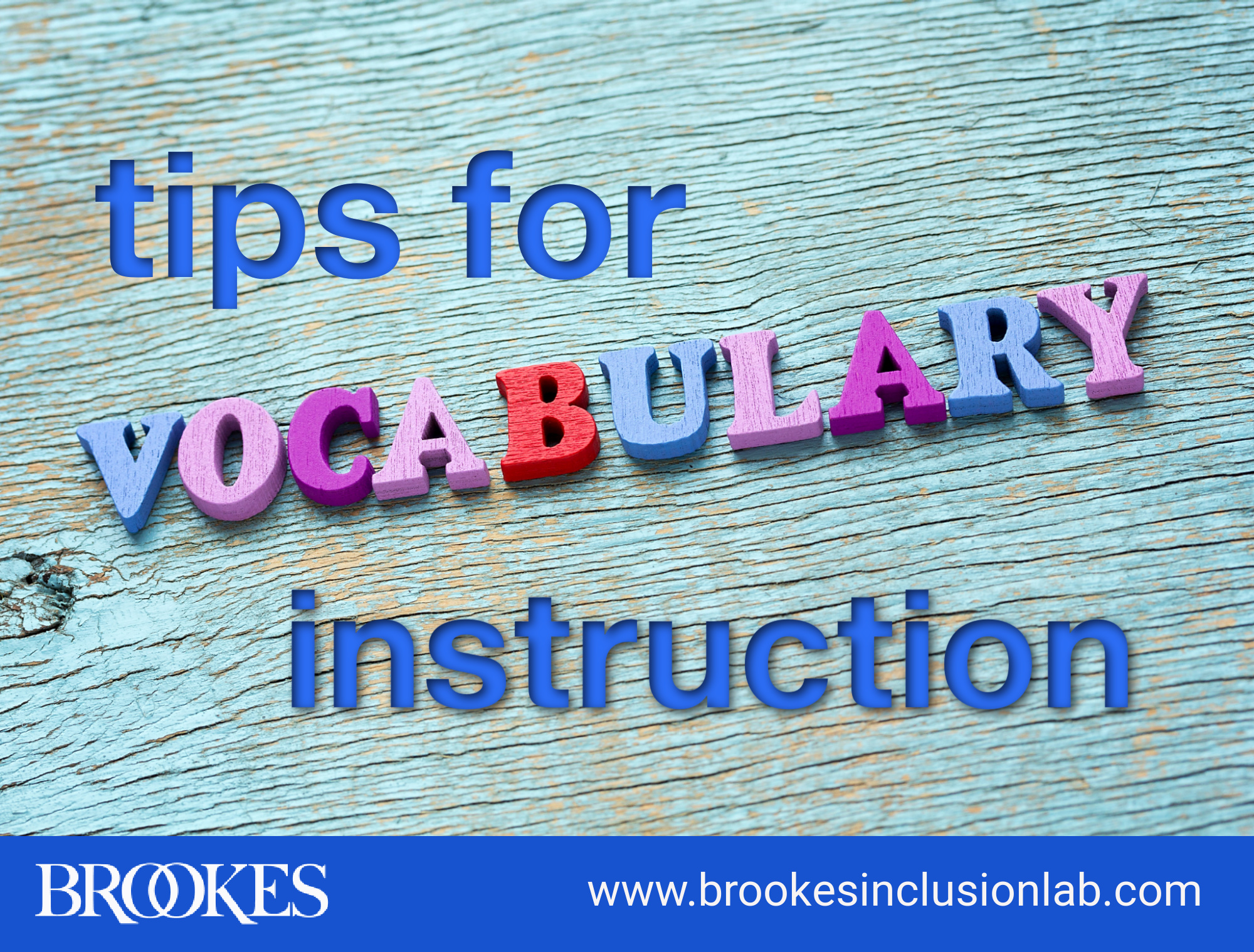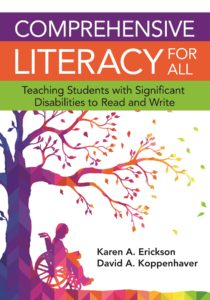Vocabulary Instruction Tips for Students With and Without Disabilities
February 9, 2021
Because vocabulary is such a critical aspect of language and reading comprehension, effective vocabulary instruction is important for students of all ages and ability levels. Good vocabulary instruction goes beyond teaching definitions of words—it involves helping students develop a deep and complete understanding of words and what they mean.
 All students can acquire new vocabulary when they’re provided with skillful instruction and rich opportunities to explore words. In today’s post, excerpted and adapted from Comprehensive Literacy for All, by Karen Erickson & David Koppenhaver, you’ll learn about five approaches to supporting vocabulary learning for your students. (Although this book is about literacy for students with significant disabilities, most of the ideas in this post can apply to students with and without disabilities.)
All students can acquire new vocabulary when they’re provided with skillful instruction and rich opportunities to explore words. In today’s post, excerpted and adapted from Comprehensive Literacy for All, by Karen Erickson & David Koppenhaver, you’ll learn about five approaches to supporting vocabulary learning for your students. (Although this book is about literacy for students with significant disabilities, most of the ideas in this post can apply to students with and without disabilities.)
Build Curiosity About Words
Help students recognize when they encounter unknown words and increase their interest in learning about the meaning of those new words and how they relate to known words. To promote students’ curiosity about words, try these ideas:
- Actively encourage students to look for new words in and out of school
- Dedicate a bulletin board to displaying and celebrating new words
- Have your students add words to personal and class dictionaries
- Read books with interesting vocabulary words (e.g., the Lemony Snicket series)
- Keep a new word jar, and put counters in the jar each time students use a novel word or recognize that they have encountered one during reading and listening. Have a word celebration when the jar is full!
- Write stories independently or as a group using many of the new and interesting words your students have learned
- Play a Jeopardy-style game. Display newly learned words and have students earn points by responding with questions.
Engage in Interactive Read-Alouds
Read-alouds are important for all students, but especially crucial for learners with more significant disabilities—many of whom struggle with vocabulary because they’ve had limited access to texts for reading and listening. Reading books and other materials out loud to students can give them access to a wide range of diverse vocabulary words they might otherwise never encounter, which can help close the word gap for students with significant disabilities.
Here are some tips to consider for your classroom read-alouds:
- Read diverse text types aloud to students (be sure they fall within the range of the students’ listening comprehension abilities).
- When you’re reading aloud and encounter words that are unfamiliar to your students, briefly explain the words and continue reading. If you feel the words need more explanation or want to include them in more explicit vocabulary instruction, talk about them when you’re finished reading.*
- Encourage students to engage in talk about the book with you and each other.
- As students develop their skills, extend their access to vocabulary learning by encouraging them to engage in self-directed reading of different types of texts.
Focus on Connections
Your students will build stronger vocabulary skills when they can connect the new words they learn to other words they know. Here are a couple strategies you can use to build connections between words:
- Make a web of connections. Start a word web on one wall of your classroom. When your students encounter a new word, have them write it on a small paper plate or Post-It and determine (with assistance from you or their peers, if needed) how the new word can be connected to other words in the web. If the new word is similar in meaning to another word, they can connect the two words with a strand of black yarn. If the new word is an antonym of another word, the connection can be “drawn” with a strand of red yarn. Your student (with or without support) can write the explanation for the connection on an index card and post it on the yarn connecting the words.
- Try word chaining (and variations). Introduce new words and ask students to determine other words they know that are connected to the target word. For example, if you’re teaching a unit on habitats, you can briefly explain the concept of a desert and then ask your students to contribute words related to the word You might try starting with words that are already familiar to the students—for example, you can present two known words like silo and warehouse and ask students to describe how they are related (e.g., they store things). You can also present students with a set of words and ask them to find pairs that are related in some way and then explain the relationship. New words can be introduced when students are increasingly successful in determining the connections between the known words.
Select Vocabulary to Teach
When you select vocabulary to teach, focus on high-utility words that are likely to appear across a variety of academic domains and contexts. Determining which words to teach will depend on your students’ existing vocabulary skills. If you teach in an inclusive classroom with students who have significant disabilities, don’t assume they have the same vocabulary base as their peers without disabilities—some will have more robust vocabulary skills, while other learners may have relatively limited vocabularies. Beck and colleagues* proposed three tiers of vocabulary to consider:
- Tier 1: Includes the common, everyday words most students know by second or third grade. The approximately 8,000 words in Tier 1 include the core vocabulary words that are often the focus of AAC and several thousand additional words. (Don’t take for granted that students with significant disabilities understand these words.)
- Tier 2: About 7,000 additional words that are less frequent but still appear across the content domains in school. These words are important for students to learn in order to read a wide range of text with comprehension. Many of the process words that appear in directions at school (e.g., describe, determine) are found in this tier.
- Tier 3: The hundreds of thousands of words in this tier are low frequency and content specific. These are the words that appear in bold in textbooks and other domain-specific texts. We rarely choose to teach these directly, but we use them in meaningful contexts as appropriate.
The words you choose to teach students with significant disabilities should come largely from Tier 2, unless you know that the students are still acquiring Tier 1 words.
(For specific guidance on selecting academic vocabulary words to teach, see the book Academic Vocabulary for Middle School Students.)
Tailor Vocabulary Instruction for Students Who Use AAC
Even with the most high-tech augmentative and alternative communication options, it’s difficult to provide students who use AAC with meaningful access to the approximately 8,000 words in Tier 1, let alone the additional 7,000 in Tier 2. But not teaching those words puts these students at a great disadvantage. To strengthen vocabulary instruction for students who use AAC:
- Teach students to use the words they do have available on their communication systems to talk about the new words they are learning. (For example, instead of selecting a single word such as escarpment, show your student how to express an understanding of that word by using available words like big, tall, hill, close, and water.)
- When students are unable to say words aloud using speech, ask them to say the words to themselves (i.e., in their heads).
- Focus some time each day on improving students’ spelling and writing skills, so that one day the students will be able to say whatever words they want using spelling.
If you liked today’s post and are looking for more in-depth guidance on helping students with significant disabilities learn to read and write, check out the book:
 Comprehensive Literacy for All
Comprehensive Literacy for All
By Karen Erickson & David Koppenhaver
Drawing on decades of classroom experience, the authors present their own innovative model for teaching students with a wide range of significant disabilities to read and write print in grades preK–12 and beyond. Foundational teaching principles blend with concrete strategies, step-by-step guidance, and specific activities, making this book a complete blueprint for helping students acquire critical literacy skills they’ll use inside and outside the classroom.
LEARN MORE




Write a Comment
Your email address will not be published. Required fields are marked *
Post a Comment